
International Research Journal of Engineering and Technology (IRJET) e-ISSN: 2395-0056
Volume: 12 Issue: 04 | Apr 2025 www.irjet.net p-ISSN: 2395-0072


International Research Journal of Engineering and Technology (IRJET) e-ISSN: 2395-0056
Volume: 12 Issue: 04 | Apr 2025 www.irjet.net p-ISSN: 2395-0072
Ritwik Sinha1 , Rahul Gupta2
1M.Tech. (CSE) Scholar, Department of Computer Science and Engineering, S. R. Institute of Management and Technology Lucknow, Uttar Pradesh, India
2Assistant Professor, Department of Computer Science and Engineering, S. R. Institute of Management and Technology Lucknow, Uttar Pradesh, India
Abstract - Millions of microblogs and social media websites post public sentiments and ideas alongside informationaboutthepresentsituationfollowingcrisesor tragedy events. While the majority of prior research has focused on gathering contextual information, it focusses onaparticularnon-situationalcategoryoftweets thatis, social tweets that make derogatory remarks targeting other racial or religious groups. To develop a classifier that performs significantly better than current methods for separating tweets that are communal from those that are not. Paradoxically, a significant portion of group tweets are posted by well-known people, the majority of whom discuss politics and the media. Furthermore, those who tweet about communities build robust, social mediarelatedcommunities.Therefore,forsecuritypurposes,itis necessary to categorise such posts from websites. This thesis proposes a novel, non-event driven strategy for characterisingcommunalmicroblogsthatwillbeusefulin theeventofacalamity.Additionally,aprocessisdesigned toidentifydangerousURLsinthesekindsofsituationsfor securityreasons
Key Words: media websites post, fake tweets, social media,communalmicroblogsetc
Online social media (OSM) such as Twitter and Facebook are really plagued by hostile and depressing substances like trolling, digital bullying, hate speech, etc. today. Different types of hostile substances. Hate speech can be divided into a few classes in which people address different characteristics, e.g., religion, sexual orientation, gender,ethnicity,nationality,etc.,oftheobjectivemeeting [6]. Kinds of contemptuous speeches, in this work they focus on a particularly hurtful and potentially dangerous class:communal tweets coordinated with certain strict or racialnetworks,forexample"Hindu","Muslim","Christian" etc. In particular, study communal tweets posted during times of disaster or crisis. A fiasco circumstance largely affects the minds of the majority and renders them powerless. Under such circumstances, contempt and falsehood grow in the affected area, which can lead to a realweakeningofpeacerelations.Inthisthesis,presenta point-by-point investigation of community tweets
published under catastrophic circumstances, e.g., programmed recognition of such tweets who break down customers who post such tweets and also recommend an approach to counteract this substance. These hostile tweets were previously posted frequently during manmade disasters such as militant psychological attacks. For example, Burnap and Williams have thrown light on U. DuringtheWoolwichraid,K.masses focusedonaspecific strict network that the raiders are associated with events such as floods and earthquakes. Some examples of communitytweetsaregiveninTable1.1.
Table1.1:TweetsSet
SR. No. Text
1 F**kthese Missionaries whoarescavengingfrom whatever’sleftafterthe#NepalEarthquakeHavesome shame&humanity.
2 Dear#kashmirFloodstakeawayallrapist muhammad’s piglets outofkashmirwithyou,whoforcedoutkashmiri Hindus fromtheirmotherland!!
3 Radical Muslims wanttobeheadu,moderateMuslims wantradicalMuslimstobeheadyounliberalswantto savethem.result.#GurdaspurAttack.
4 RT@polly:#HillaryClinton’sreplywhenaskedifwaron terrorisawaron “radical Islam” #DemDebate.
5 JesusF***ingChrist...ActiveshooterreportedinSan Bernardino,California.
Social media platforms' explosive expansion has completely changed how people communicate, exchange information, and build communities. Social media platforms like Facebook, Instagram, Reddit, and Twitter (now X) have become vital information channels for anything from breaking news and personal updates to political debate and business advertisements. The dissemination of malicious URLs is one of the most commonwaysthatmaliciousgroupstrytotakeadvantage of consumers, yet this widespread influence also draws themin.

International Research Journal of Engineering and Technology (IRJET) e-ISSN: 2395-0056
Volume: 12 Issue: 04 | Apr 2025 www.irjet.net p-ISSN: 2395-0072
Theobjectivesofthisthesisare:
To do extensive research works on detection of hate or loathing speech over social media websites.
To implement a classifier on detection of communalpostsfromdatasetoftweets.
Tomodifythefeaturesinsuchawaytodetectthe malicioususer’sURLtweetsinthepost’sdataset.
To propose a method to detect both malicious URLanddetectionandclassificationofcommunal andnon-communalposts.
2.1. Cyber Hate Speech on Twitter: An Application of Machine Classification and Statistical Modelling for Policy and Decision Making
The application of "big data" to focus and fundamental leadership is a hot topic right now. The murder of drummer Lee Rigby in Woolwich, London, UK, in 2013 garnered extensive social media attention and offered a chance to consider the proliferation of digital hate on Twitter.InordertocreateandtestacontrolledAIcontent classifier that would recognise teasing or possibly hostile replies connected to race, ethnicity, or religion, as well as larger and wider responses, one person wrote on Twitter thatthedatawasgatheredshortlyafterRigby'sdeath.The key components of characterisation, which include the syntactic situations between phrases to perceive "other" phrases,the encouragement to respond withthe opposite activity, and instances of established or defended social gatherings of oppression, have been taken from the content of each tweet. They performed best when they combined probabilistic, rule-based, and spatial classifiers with a metaclassifier to gather votes. The author demonstrates how the classifier's aftereffects may be efficiently used in a measurable model to assume the plausiblespreadofonlinehateusingdata fromTwitter.It concerns mediation applications and fundamental leadership.[1]
In this article, the author created a managed AI classifier for despicable and negative substances on Twitter. The classifier's goal is to assist managers and authorities in observing the public response to emotional events on a broad scale, such as the 2013 Woolwich murder of drummer Lee Rigby. According to earlier studies, 58 percent of negative acts that took place after September 11th were hated two weeks after the incident (4 percent of the risk period). The information is continuously accessible through online social networks and microblogging platforms like Twitter, which can help us weed out the pervasive hate and hostile responses on the
internet as soon as the threat of hateful responses is greatest.
Socialmediaframeworksprovideinternetcustomerswith a harmonious frame work in which to express their thoughts and assessments uninhibited. While this quality speaks of incredible and extraordinary mailings, it also brings with it significant difficulties. One unique instance of this kind of issue is hate speech on the internet. The concept of hate speech on social media is not well understood, despite its magnitude and scope. The author usesTwitterandWhisperastwosocialmediaplatformsto dothis.Atthisstage,theauthordevelopsandauthorisesa method for differentiating between hate speech in both frameworks. By providing the avoidance and recognition of raw titles close by, the author's findings differentiate Internet contemptuous speech structures and provide a morecomprehensivecomprehensionoftheissue.
A increasing number of influential people and dynamic associations, as well as governments and commercial companies, are joining the fight against the blatant rhetoric of disgust on the Internet. This important problem in avant-garde society is now evident. The author's efforts even reveal new types of loathing on the internet that are not really bad deeds but can be dangerous to people. The author is confident that the author's data set and methodology can help review the frames and location calculations to spot novel slogans identifiedwithhatespeechaswellasmovingincreasingly exposed components to shift language of hate on the internetdistinguish.Researchplan.[3]
The system improvement lifecycle (SDLC) or software programimprovementlifecycleinframeworklayout,facts frameworks, and programming layout is the manner to createoradjustframeworksandfashionsandapproaches thathumanbeingsusetocreatetheonesframeworks.The SDLC concept helps many sorts of programming improvement systems. These philosophies shape the device that allows you to prepare and manipulate the introduction of a facts body with inside the product improvementprocess.
3.1.
3.1.1
The author for the current communal post detection system has provided a concept for detecting regular or communal tweets but has not provided a concept for detecting malicious users, and malicious users are often

International Research Journal of Engineering and Technology (IRJET) e-ISSN: 2395-0056
Volume: 12 Issue: 04 | Apr 2025 www.irjet.net
responsible for spreading communal tweets, so a new proposed concept is applied to detect such malicious users.AlmosteverytweetcontainsaURLlinktoavideoor othergreetingdocument.SinceURLscanhavealongtext, but Twitter will only support 140 characters, Twitter has adopted the SHORTEN URL rule, in which a long URL can bemappedtoashorterURL.ShortenURLsmaybeusedin tweets, and when a user clicks on one, Twitter obtains a largeURLmappingfromShortenURL.
Example
StackoverflowsshortenURL
ShortURL=http://s.tk/
When one paste above short URL in browser and then pressenterkeythenautomaticallythatURLchangestobig URLasbelowone
BigURL=https://stackexchange.com/
Malicious users could use this strategy to disperse tweets with Shorten URLs that will redirect users to malicious websitesastheyclickonthem.Themaliciouswebsitethen extracts data from the user's computer and sends it to othermalicioususers.
Malicious users will always have only one or a few websites, and they will build thousands and thousands of shorten URLs that point to those few malicious websites. Userscanberoutedtosuchwebpagesiftheyclickonsuch URLs.
TwitteralreadyusesblacklistedURLstodetectsuspicious connections, but this is insufficient to detect various shorten URLs. To fix this challenge, all URLs can be investigatedtoseeifthesamewebpageisbeingredirected by each of them. A URL may be flagged as dangerous if multiple Shorten URLS drive users to the same website; maintainingablacklistofURLsisnotnecessary.Thisisthe system'ssuggestedconceptfeaturetechnique.
BelowisthecodetogetexpandURLfromshortURL
public static String expand URL (String shortened URL) throwsIOException
A software engineer can use modelling notation, which is determined by a set of pragmatic and semantic syntactic rules, to define an analytical model with the UML. Five distinct viewpoints, each describing the system from a different angle,areused toillustratea UML system. Each view is defined by a series of diagrams that are shown below.
View of the User Model
p-ISSN: 2395-0072
i. The system is rendered from the user's point ofviewinthisview.
ii. The analysis's rendering provides an enduserperspectiveonausagescenario.
i. Thisparadigmisusedtoretrievethesystem's dataandcapabilities.
ii. This model view represents the static structures.
The behaviour model view depicts the interactions between different structural elements as well as behaviouraldynamicsassystemcomponents,asshownin theusermodelandstructuralmodelview.
Implementation-Model View:
This shows how the system's behavioural and structural elementswillbedeveloped.
Environmental-Model View:
This shows the system to be used as well as the behaviouralandstructuralfeaturesoftheenvironment.
The most crucial component of object-oriented modelling is the class diagram. Both technical modelling, which converts concepts into programming code, and wide conceptualmodellingofsoftwaresystemsaredonewithit. Facts can also be modelled using class diagrams. Along with the interactions inside the software and the training thatneedstobecoded,theyarethemaincomponentsofa categorydiagram.
A magnificence with 3 sections, within side the diagram the training are represented via way of means of packing containerswith3parts:
Thehigherelementbearsthecallofthemagnificence.
Thecentreelementconsistsoftheattributes.
The decrease element consists of the techniques or operations that carry out or be capable of carry out themagnificence

International Research Journal of Engineering and Technology (IRJET) e-ISSN: 2395-0056
Volume: 12 Issue: 04 | Apr 2025 www.irjet.net p-ISSN: 2395-0072
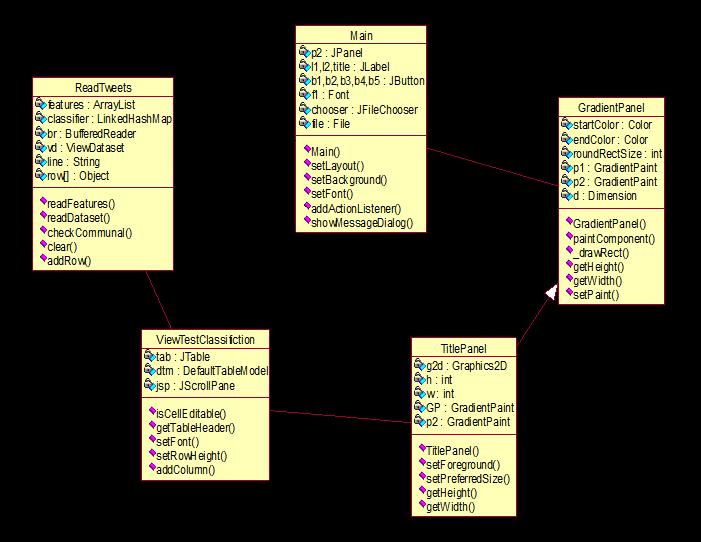
3.1:Classdiagram
3.1.4 Use case diagram
Initssimplestform,ausecasediagramisarepresentation of a user's interaction with a system that outlines the requirements of a use case. The many types of system users and the different ways they can communicate with the system are shown in a use case diagram. Other diagram kinds usually follow this one, which is usually usedinconjunctionwithawrittenusecase.

Figure3.2Usecasediagram
3.1.5 Activity diagram
Another helpful UML diagram for illustrating intricate systemcomponentsistheactivitydiagram.Inessence,itis a flowchart that shows how data moves between processes. The activity can be specified by a machine process.Controlisconsequentlypassedfromoneactionto the next. This flow may naturally be synchronous, branched,orsequential.
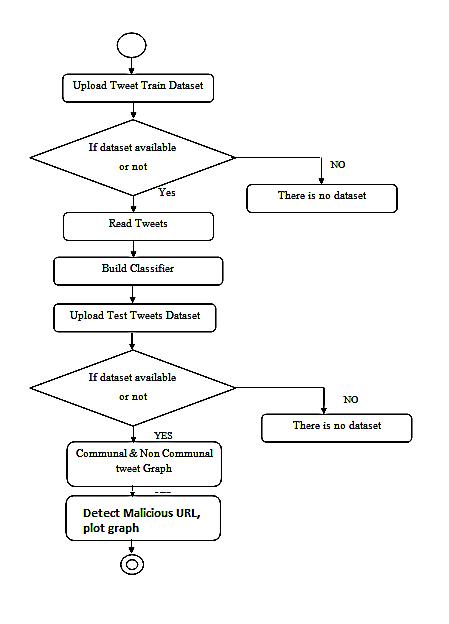
3.3:Activitydiagram
3.1.6 Data Flow Diagram
DF diagrams display the inputs and outputs of a system's data processing. Data flow diagrams are a useful tool for successfully illustrating any business function. The methodstartswithageneralsummaryofthebusinessand progressesthrougheachofthem.thefunctionallyrelevant areas. The amount of depth required for this analysis can beachieved.Themethodologyusesatechniquecalledtopdownexpansiontocompletetheanalysis.
As the name suggests, a data flow diagram (DFD) is a graphic representation of the information movement within a process. A DFD can be made with basic symbols. Furthermore, simple, freely downloadable graphical tools for creating DFDs make it simple to automate complex processes. One paradigm for creating and assessing

International Research Journal of Engineering and Technology (IRJET) e-ISSN: 2395-0056
Volume: 12 Issue: 04 | Apr 2025 www.irjet.net p-ISSN: 2395-0072
information processes is a DFD. DFD uses inputs and outputs to show how information moves through a process. A DFD is also known as a process model. A DFD illustrates a technological or business process supported by stored external data, data flowing between processes, andtheoutcomes.
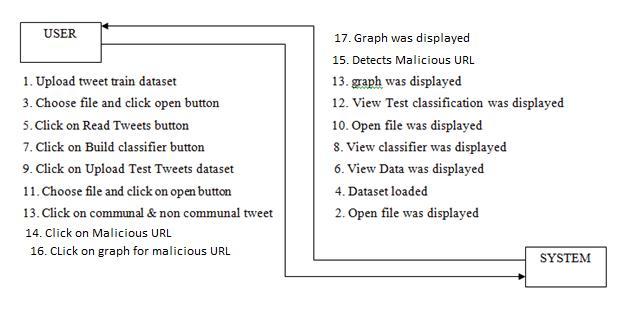
4.1 TESTING
4.1.1 Testing and Deployment:
One of the most vital activities in an undertaking is deployment or implementation. This is the method wherein one needs to be vigilant, ensuring that all efforts made throughout the undertaking are interactive. The most crucial step in achieving a stable and strong system, whileassuringclientsthattheimplementation ofthenew system is dependable and usable. During implementation, eachapplicationisindependentlytestedusingsampledata to make sure it works as required by the program specifications. To guarantee user comfort, the operational toolanditssurroundingshavebeenthoroughlyexamined.
4.1.1.1 Deployment
The implementation stage is less creative than the device design stage. Its main objectives are file conversion and user education. A lot of user training might be necessary forthedevice.Thesystem'sstartingparametersshouldbe modified appropriately as a result of programming. To help the user comprehend the many functions, a fundamental working technique is presented. Depending ontheuser'saccess,reports canbeprintedusing either a dot matrix printer or an inkjet printer. Setting up the suggestedframeworkiseasy.
Generally speaking, "implementation" describes the procedurethatturnsarevisedornewdevicespecification intoaworkingsystem.
The process of creating test data and using it to look at specificmodulesandthevalidationofferedforthefieldsis called testing. Device testing is the following stage, which confirms that every part of the system functions as a whole. It is important to select the test data such that it canbeusedtoa rangeofscenarios.Inactuality,testing is thestageofdevelopmentwherethedeviceisexaminedto make sure it functions correctly and consistently before the actual process starts. A list of the research methods employedduringthetestingprocedureisprovidedbelow.
In the information technology sector, testing is now a crucial component of all projects and products. the significance of testing in establishing whether one should resist or whether one is prepared to move on. It is impossibletooverstatehowseriousasituationis,whichis why pre-production testing is essential: Software should be tested to make sure it is performing the intended functionbeforebeingmadeavailabletothegeneralpublic. Several methods will be used in the study to confirm the software'sreliability. A program executionsequencefora data series was simulated, and the program was logically evaluated. Consequently, the Code has been carefully examinedforanypotentialflawsorrecommendations.
Errors are found by individually verifying each module. This enables us to find and fix errors without interfering with other modules. To achieve the intended result, a program must be fixed if it is unable to complete the necessaryoperation. Separategradesareassignedtoeach module,startingwiththesmallestandlowestandworking up to the next level. Every gadget module is examined independently. Thejobclassificationmodule,forinstance, is examined independently. The average execution of manyjobsisusedtoverifythismodule. Theoutcomesare contrasted with those that were manually produced. The findingsimplythatthesuggestedsystemoutperformsthe existing one in terms of effectiveness. Every gadget module is examined independently. Job planning and resource classification modules are assessed independently in the process's waiting time is shortened by this plan and the associated outcomes that are gathered.
Integration testing is done in addition to module inspection. When connecting the modules, there is a chance that faults will arise; this inspection will fix these mistakes. Inthisframework,bothmodulesareconnected and verified. Consequently, the system completes the resourcejobassignmentsuccessfully.

Volume: 12 Issue: 04 | Apr 2025 www.irjet.net p-ISSN: 2395-0072
When the user finds no significant problems with the accuracy of the system, it passes a final acceptance test. Without needing actual implementation, this test ensures that the framework satisfies the initial goals, objectives, and requirements set during the review, saving administratorsanduserstimeandmoney.Acceptancetest Finally,thetimehascome,andyouarepreparedtodepart.
Table4.1:Testcases
01 Upload Tweet Train Dataset Verify Whethe r dataset uploade d or not
not uplo ad
02 Read Tweets Check test tweets is reading ornot If it’s not read ing
03 Build Classifie r Verify whethe r classifie ris processi ngor not If it’s not proc essi ng
otget classi fier
Classi fier displ ayed
04 Upload test tweets dataset Verify whethe r dataset is availabl eornot If it’s not avai labl e cann ot see test classi ficati on View Test classi ficati on
05 Commu nal& Non commu nal Tweets Graph Verify the graphis processi ngor not If it’s not proc essi ng cann otget tweet grap h Com muna l& non com muna l graph displ ayed
h
4.2.1 Classification of Micro blogs & detection of Malicious URL proposed work results:
Results and screenshots of the current system implementation are displayed in this section. Figure 4.1 displays the application GUI, or graphical user interface, window

Figure4.1:GUIofimplementationofexistingsystem
The buttons on the GUI are: Read Tweets, Compile Classifier, Load Tweet Dataset for Testing, Load Tweet StreamDataset,andResults DiagramforCommunal and Non-CommunalResults.
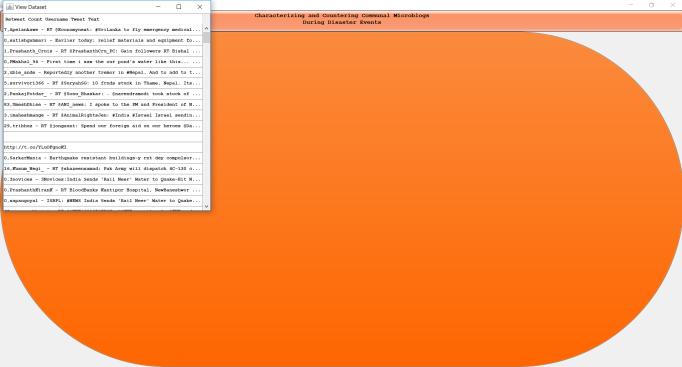
Figure4.2:Datasetfortweets
The data set of trained tweets is displayed in figure 4.2. Classification following the build classifier button is displayedinfigure4.3.
h
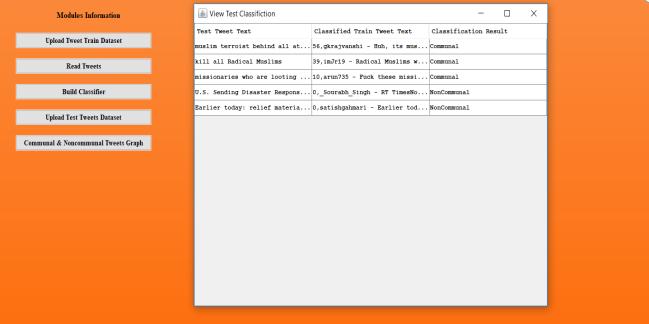
Figure4.4:TestResultsofClassification

International Research Journal of Engineering and Technology (IRJET) e-ISSN: 2395-0056
Volume: 12 Issue: 04 | Apr 2025 www.irjet.net p-ISSN: 2395-0072

4.5:Communal&Non-communaltweetsgraph
In figure 4.4, test results after classification are shown. In figure 4.5, the chart of communal and non-communal tweetsisshown
5.1. Conclusions
This thesis is the main project aimed at characterising group tweets that were posted during the disaster and looking into the users who posted those tweets with malicious URLs. An event-independent classifier is suggested here, which might be used to sort through shared tweets beforehand. Additionally, it was found that public tweets are heavily retweeted and shared with the help of a number of well-known users; they typically contain information about media and governmental issues.Clientswhouseandadvancecommunalsubstances haveastrongsocialtiewithoneanother.Additionally,the vast majority of patrons unexpectedly explode as a result of these kinds of actions, particularly their animosity towards the event's expressly stringent networks. It's important to reduce the potential negative effects of communaltweetssince,intimesofcrisis,someconsumers frequently submit to communal content, which annoys people. have suggested an event-independent classifier to distinguish between these hostile tweets. However, it has been discovered that these anti-community tweets are retweeted far less frequently than those that are communal, and they may also no longer be as widely shared. Finally, a continuous framework that classifies tweets as either communal or non-communal and diagnosesmaliciousURLsforsecuritypurposes
5.2. Future Scope
There are numerous ways in which this research can be enhanced in the future. Advanced AI and language processing techniques can be used to increase the accuracy of the event-independent classifier. Real-time technologies that collaborate closely with social media platforms can be created to identify and stop the propagation of damaging community tweets. Scams, false information, and cyber threats can all be detected by
expanding the identification of harmful links in tweets. One way to understand why people post such stuff on social media and how to prevent it is to look at how they respond to crises. To observe how community content travels across many networks, this study can potentially beexpandedtoothersocialmediasiteslikeFacebookand Instagram.Thesefindingscanbeusedbypolicymakers to develop more effective regulations that protect free expression while limiting harmful information. Lastly, social media may be made safer in emergency situations by developing scalable AI systems that can manage massivevolumesofdataandautomaticallygetbetterover time.
[1] P. Burnap and M. L. Williams, “Cyber hate speech on Twitter: An application of machine classification and statisticalmodelingforpolicyanddecisionmaking,”Policy Internet,vol.7,no.2,pp.223–242,2015.
[2]I.Chaudhry,“#Hashtagginghate:UsingTwittertotrack racismonline,”FirstMonday,vol.20,no.2,2015.[Online]. Available: http://firstmonday.org/ojs/index.php/fm/article/view/5 450
[3] L. A. Silva, M. Mondal, D. Correa, F. Benevenuto, and I. Weber, “Analyzing the targets of hate in online social media,”inProc.ICWSM,Mar.2016,pp.687–690.
[4] N. D. Gitari, Z. Zuping, H. Damien, and J. Long, “A lexicon-based approach for hate speech detection,” Int. J. Multimedia Ubiquitous Eng., vol. 10, no. 4, pp. 215–230, 2015.
[5] I. Kwok and Y. Wang, “Locate the hate: Detecting tweets against blacks,” in Proc. 27th AAAI Conf. Artif. Intell.,2013,pp.1621–1622.
[6] M. Mondal, L. A. Silva, and F. Benevenuto, “A measurement study of hate speech in social media,” in Proc.ACMHT,2017,pp.85–94.
[7] N. Djuric, J. Zhou, R. Morris, M. Grbovic, V. Radosavljevic,andN.Bhamidipati,“Hatespeechdetection withcommentembeddings,”inProc.WWW,2015,pp.29–30.
[8]W.Magdy,K.Darwish,N.Abokhodair,A.Rahimi,andT. Baldwin, “#ISISisNotIslam or #DeportAllMuslims?: Predicting unspoken views,” in Proc. ACM Web Sci., 2016, pp.95–106.
[9] K. Rudra, A. Sharma, N. Ganguly, and S. Ghosh, “Characterizing communal microblogs during disaster events,” in Proc. IEEE/ACM ASONAM, Aug. 2016, pp. 96–99.

International Research Journal of Engineering and Technology (IRJET) e-ISSN: 2395-0056
Volume: 12 Issue: 04 | Apr 2025 www.irjet.net p-ISSN: 2395-0072
[10] E. Greevy and A. F. Smeaton, “Classifying racist texts using a support vector machine,” in Proc. SIGIR, 2004, pp. 468–469.
[11] N. Pendar, “Toward spotting the pedophile telling victim from predator in text chats,” in Proc. ICSC, Sep. 2007,pp.235–241.
[12] Y. Chen, Y. Zhou, S. Zhu, and H. Xu, “Detecting offensive language in social media to protect adolescent online safety,” in Proc. Int. Conf. Social Comput. Privacy, Secur., Risk Trust (PASSAT), (SocialCom), Sep. 2012, pp. 71–80.
[13] K. Dinakar, B. Jones, C. Havasi, H. Lieberman, and R. Picard, “Common sense reasoning for detection, prevention, and mitigation of cyberbullying,” ACM Trans. Interact.Intell.Syst.,vol.2,no.3,p.18,2012.
[14] P. Burnap et al., “Tweeting the terror: Modelling the social media reaction to the Woolwich terrorist attack,” SocialNetw.Anal.Mining,vol.4,no.1,p.206,2014.
[15]N.Alsaedi,P.Burnap,andO.Rana,“Canpredictariot? Disruptive event detection using Twitter,” ACM Trans. InternetTechnol.,vol.17,no.2,p.18,2017.
[16] P. Burnap and M. L. Williams, “Us and them: Identifying cyber hate on Twitter across multiple protectedcharacteristics,”EPJDataSci.,vol.5,no.1,p.11, 2016.
[17] R. Delgado and J. Stefancic, “Hate speech in cyberspace,” Wake Forest Law Rev., vol. 49, p. 319, Jan. 2014.
[18] K. Jaishankar, “Cyber hate: Antisocial networking in theInternet,”Int.J.CyberCriminol.,vol.2,no.2,pp.16–20, 2008.
[19] C. Schieb and M. Preuss, “Governing hate speech by means of counterspeech on Facebook,” in Proc. 66th ICA Annu.Conf.,Fukuoka,Japan,2016,pp.1–23.
[20]E.Chandrasekharan, M. Samory,A. Srinivasan,and E. Gilbert, “The bag of communities: Identifying abusive behavior online with preexisting Internet data,” in Proc. ACMCHI,2017,pp.3175–3187.